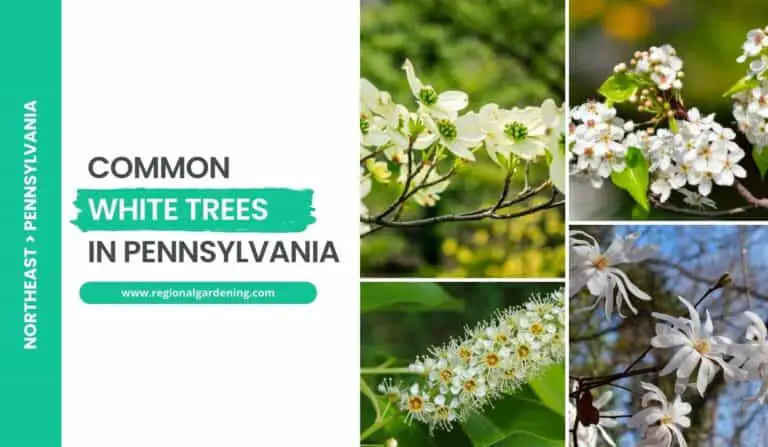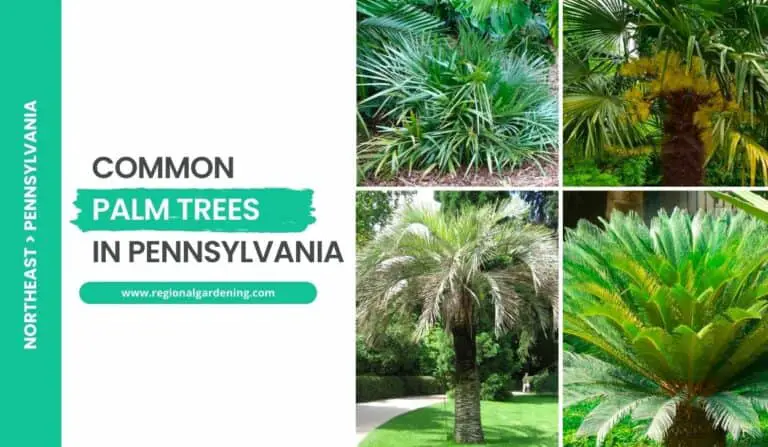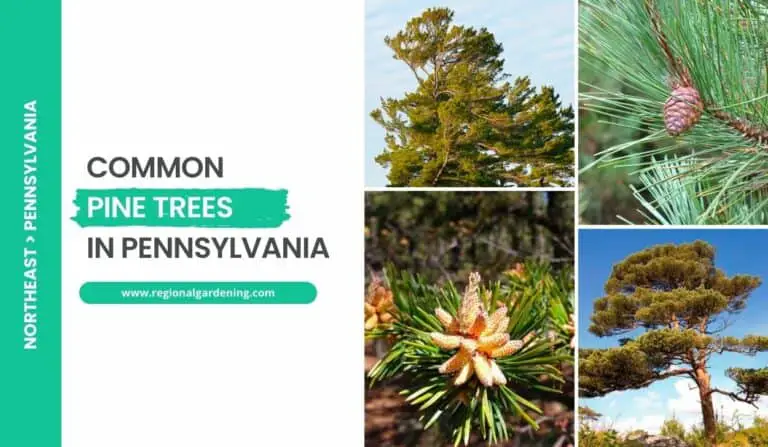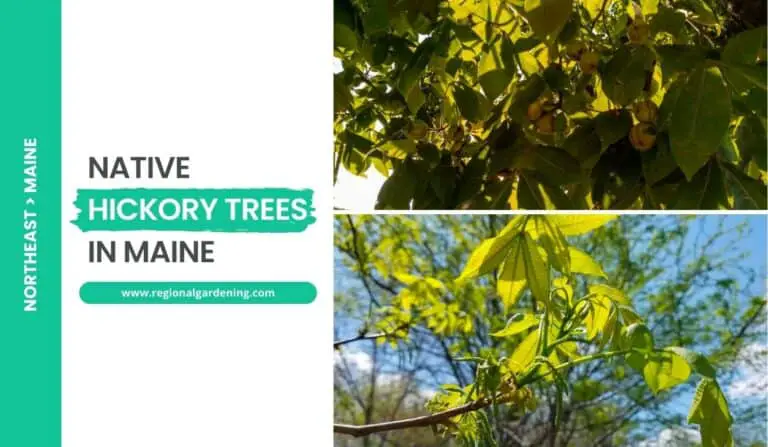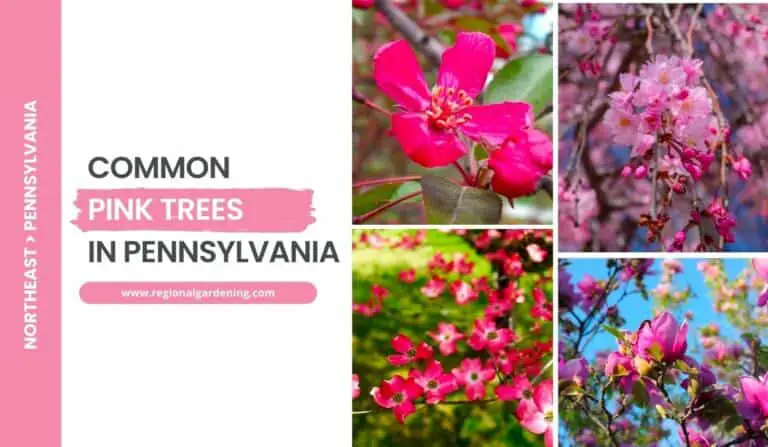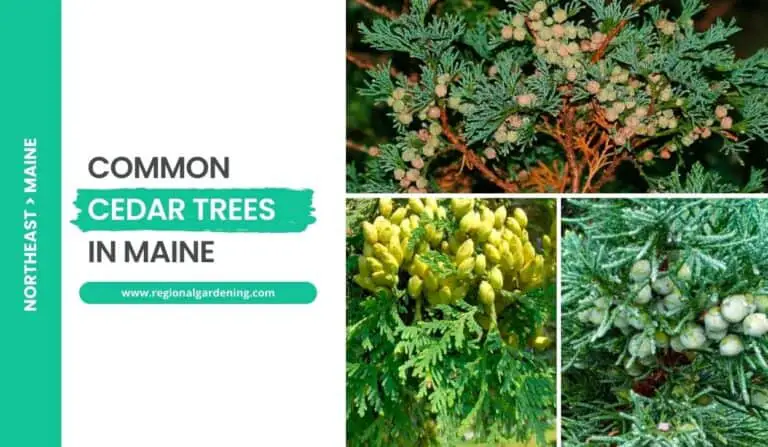7 Common Maple Trees In Pennsylvania (Photos & Identification)
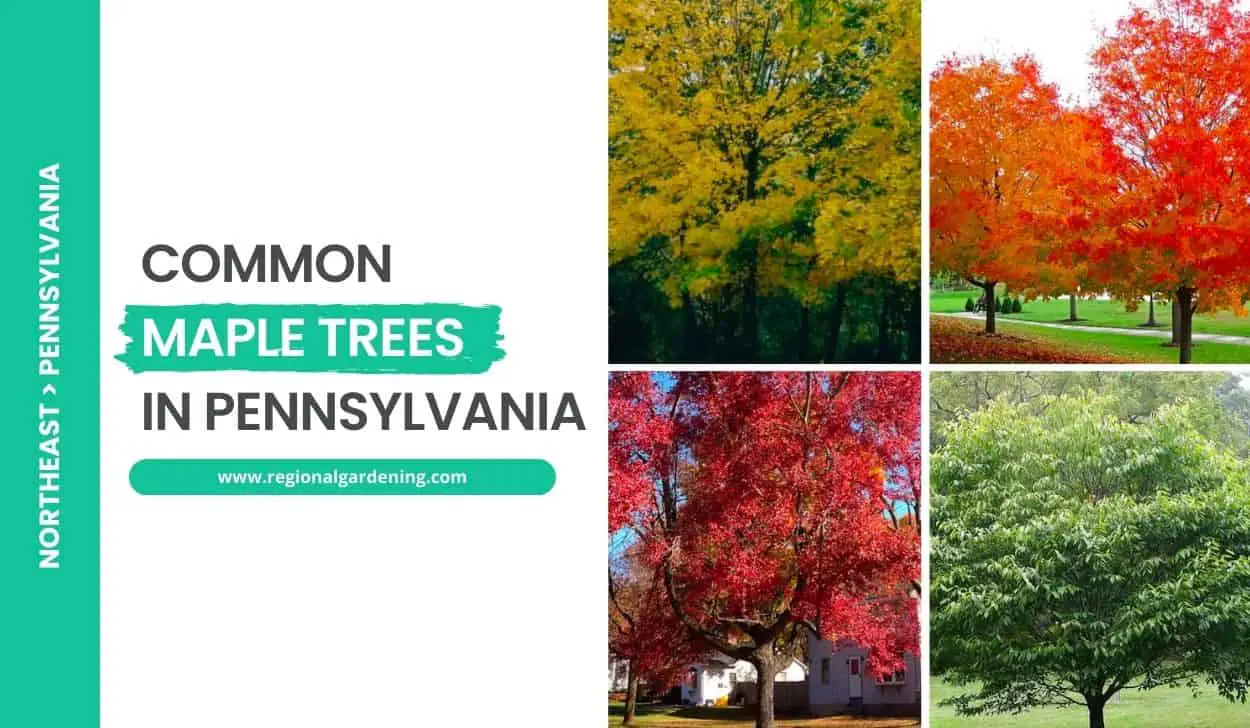
The wide variety of maple trees in Pennsylvania contributes greatly to the state’s scenic grandeur.
This article explores the seven most common maple species across Pennsylvania, providing a historical perspective on the state’s rich diversity of maple trees, from native to non-native species that have naturalized within the state’s distinctive ecosystem.
The unique characteristics, natural environments, and useful applications of each of these maple gems are discussed, with accompanying photographs for ease of identification.
So, let’s begin exploring the common maple trees in Pennsylvania.
1. Red Maple
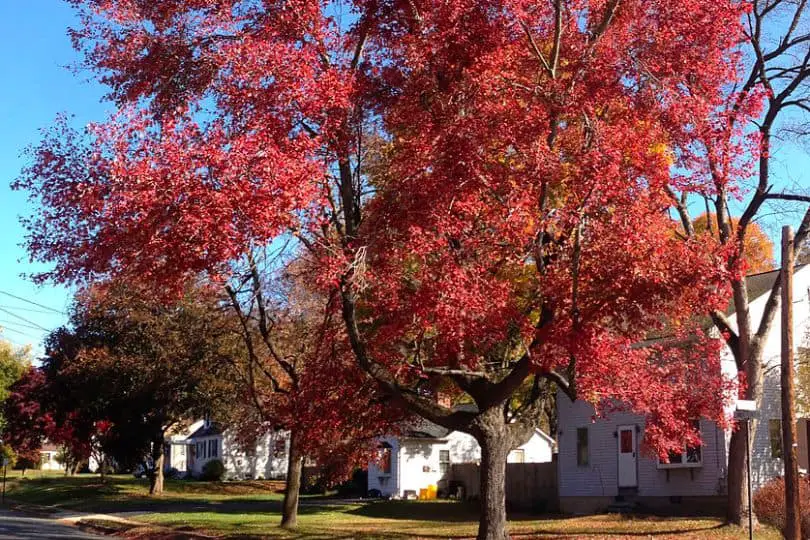
- Scientific Name: Acer rubrum L.
- Common Name(s): Red Maple
- Mature Height: 80-100 feet (24-30 meters)
- Native Region: North America
- Flowers: Small red flowers in dense clusters
- Fruits: Winged seeds called samaras, usually less than 1″ long, in pairs spreading at a narrow angle, mature in Spring.
- Uses: Red Maple is an excellent ornamental tree. Its wood is easier than Sugar Maple, making it less valuable for timber. However, it is frequently used for furniture, flooring, and cabinetry. It is also a popular choice for landscaping due to its stunning red or orange fall foliage.
The Red Maple, scientifically known as Acer rubrum L., is the most common tree in Pennsylvania and can be found in a wide range of settings. It is a huge tree that matures to 80-100 feet (24-30 meters). The Red Maple’s leaves are opposite, simple, and have 3-5 shallow lobes. They are bright green on top and pale green to yellowish on the bottom. The leaves become a vivid red or orange in fall, bringing a spectacular show of color to the environment.
Red Maple twigs are slender, and glossy, and can be red or grayish-brown in hue. Young trunks and branches have smooth, light gray bark, whereas older trunks have darker, shaggy bark with long, irregular peeling flakes. This tree derives its name from the dense clusters of little red blooms it produces. Bees and other pollinators are drawn to these flowers.
The Red Maple produces flying seeds called samaras in the spring. These seeds are typically less than 1″ long, grouped in pairs, and spread at a narrow angle. Samaras mature in the spring and are scattered by the wind. The Red Maple is also noted for its adaptability to a variety of soil conditions. It thrives in damp soils, so it’s ideal for regions with poor drainage or near water features.
Red Maple offers a variety of commercial and landscape applications. It is a beautiful ornamental tree with spectacular fall colors. Although not as hard as Sugar Maple, its wood is nonetheless precious and widely used in furniture, flooring, and cabinets. Furthermore, because of its versatility and aesthetic appeal, Red Maple is frequently used in landscaping projects. However, young Red Maple trees are severely browsed by deer and rabbits, and rats eat the seeds, therefore protective measures may be required to ensure successful growth in Pennsylvania gardens.
2. Silver Maple
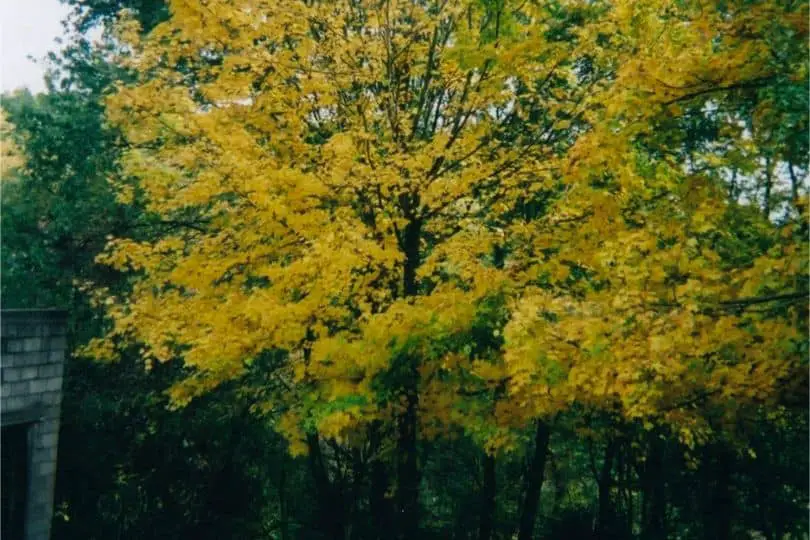
- Scientific Name: Acer saccharinum L.
- Common Name(s): Silver Maple
- Mature Height: Up to 100 feet (30 meters)
- Native Region: North America
- Flowers: No Flowers
- Fruits: Wings approximately 2 inches long, widely spreading, maturing in spring
- Uses: Planted as a shade tree, seeds are eaten by many mammals and birds
The Silver Maple, formally known as Acer saccharinum, is a huge deciduous tree that can grow to 100 feet tall. It is native to North America and can be found in wet woodlands and along stream banks all around Pennsylvania. The silver maple’s leaves are opposite, simple, and deeply 5-lobed, with a bright green upper side and a silvery-white underside. The leaves turn a greenish-yellow color in the fall.
In the spring, the silver maple twigs are slender, lustrous, and green, gradually turning a chestnut brown tint. One unusual aspect of this tree is that the lower branches frequently have an upward curve at the end. Young trunks have smooth and gray bark and older trunks have wrinkled brown bark with plates that curl out on both ends.
The silver maple yields the largest fruit of any native maple during the spring. The fruit’s wings are around 2 inches long and widely spread. The silver maple seeds provide food for many mammals and birds.
The silver maple is widely planted as a shade tree in Pennsylvania landscaping. It should be noted, however, that this tree tends to split, thus proper trimming and care are required to maintain its structural integrity. The silver maple grows well in moist soil and is well-suited to places near streams and wetlands. It is a fast-growing tree that brings beauty and shade to garden landscapes.
3. Striped Maple
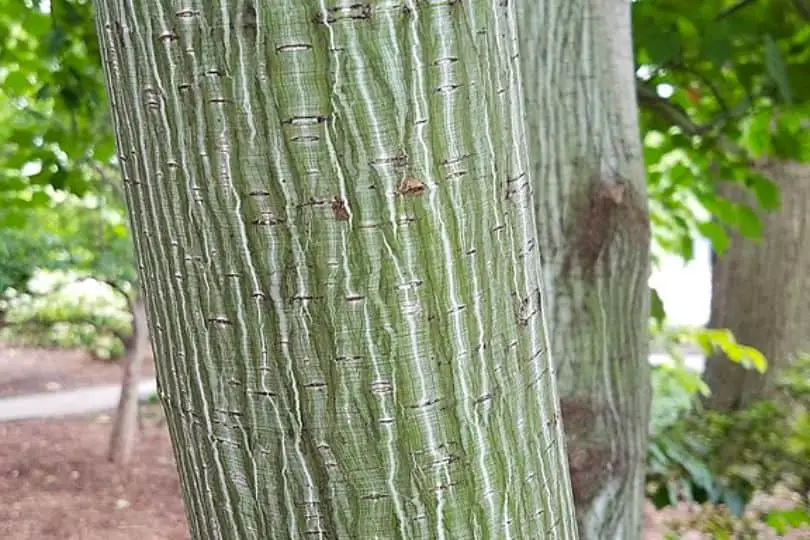
- Scientific Name: Acer pensylvanicum L.
- Common Name(s): Striped Maple
- Mature Height: 10-25 feet (3-7.6 meters)
- Native Region: North America
- Flowers: No Flowers
- Fruits: Wings about ¾” long, maturing in September in drooping clusters. Marked on one side of the seed with a depression.
- Uses: Striped Maple is often used as an ornamental species due to its attractive white stripes.
The Striped Maple (Acer pensylvanicum) is a deciduous tree endemic to North America. It is often found in Pennsylvania’s hilly areas, particularly on damp, cool, shaded slopes and deep ravines. The characteristic white stripes on the bark of this tree make it visually beautiful and appropriate for ornamental uses in gardens.
Striped Maple leaves are opposite, simple, and three-lobed. When young, they have sharply toothed borders and red pubescence on the lower surface. The twigs are first smooth and thick, greenish before turning crimson. The growth of each season is denoted by 2-3 dark lines encircling the twig. Young trees have smooth, greenish, or reddish-brown bark with longitudinal white streaks. The bark of the tree becomes harder, darker, and less striped as it ages.
Striped Maple bears fruit in the form of divergent wings in September. The wings are around 34″ long and found in drooping clusters. A depression is visible on one side of the seed. Although the tree does not have blooms, the seeds and winged fruits add to the overall beauty.
Striped Maple grows best in damp, shady conditions in Pennsylvania landscapes. It thrives in mountainous areas, cool slopes, and deep ravines. It is critical to supply appropriate moisture and keep the soil continuously moist when caring for this tree. Striped Maple also benefits from trimming regularly to keep its shape and stimulate healthy development.
Striped Maple is a popular choice for decorative landscaping in Pennsylvania gardens due to its unique bark patterns and attractive appearance. Its striking white stripes add visual intrigue to any garden or landscape, giving it a focus point. Furthermore, with a height range of 10-25 feet, it is appropriate for smaller gardens and can even be employed as an understory tree in bigger landscapes.
4. Mountain Maple
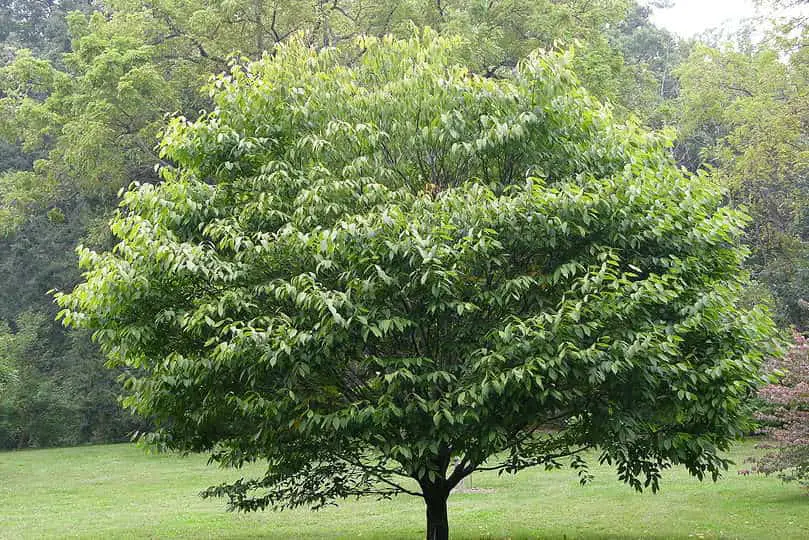
- Scientific Name: Acer spicatum Lam.
- Common Name(s): Mountain Maple
- Mature Height: 25-30 feet (7.6-9.1 meters)
- Native Region: North America
- Flowers: No Flowers.
- Fruits: Green to red fruits with slightly spread wings (samaras), ripening in September or October.
- Uses: Provides browse for deer, rabbits, and beaver. Ruffed grouse feed on its buds.
The Mountain Maple, formally known as Acer spicatum Lam., is a tiny tree or shrub that grows in the woodland understory. It has a short trunk with slender upright branches and grows to a height of around 25 to 30 feet (7.6 to 9.1 meters). The opposite, simple leaves are about 6 inches long, with 3-5 lobes and a coarsely serrated border. They are smooth on top and hairy on the bottom, turning orange or yellow in the autumn.
This species is commonly found on cool, damp rocky hillsides and ravines, where it grows with sugar maple, yellow birch, beech, white pine, and hemlock trees. While it is more frequent in northern counties and at higher elevations in Pennsylvania’s Ridge and Valley and Allegheny Mountain physiographic provinces, it is also found elsewhere in North America. Mountain Maple provides fodder for a variety of species such as deer, rabbits, and beavers. The buds of this tree provide food for ruffed grouse.
Mountain Maples have winged fruits called “samaras” that are 12 inches long. Samaras have wings that are gently extended and can range in hue from green to crimson. These fruits, which grow grouped at the ends of the twigs, ripen in September or October. Mountain Maple bark is thin, smooth, and varies in color from brown to grayish-brown, typically speckled with gray spots.
The Mountain Maple can be an excellent addition to gardens and landscapes in Pennsylvania. It enjoys moderately shaded places and thrives in well-drained soil. This tree is ideal for individuals who want to improve the understory of their forest gardens or create a naturalistic and shady part of their yard. It can also be used to attract wildlife because it provides food for animals such as deer and rabbits. Furthermore, the Mountain Maple’s vivid autumn colors make it an appealing choice for autumn foliage displays.
Mountain Maples in Pennsylvania landscapes require enough rainfall, especially during dry seasons. Mulching around the base of the tree aids in moisture retention and weed control. Pruning should be done to remove any dead or broken branches and to keep the tree in the correct shape. It is also prudent to keep an eye out for common pests and diseases and to take appropriate action if necessary.
5. Sugar Maple
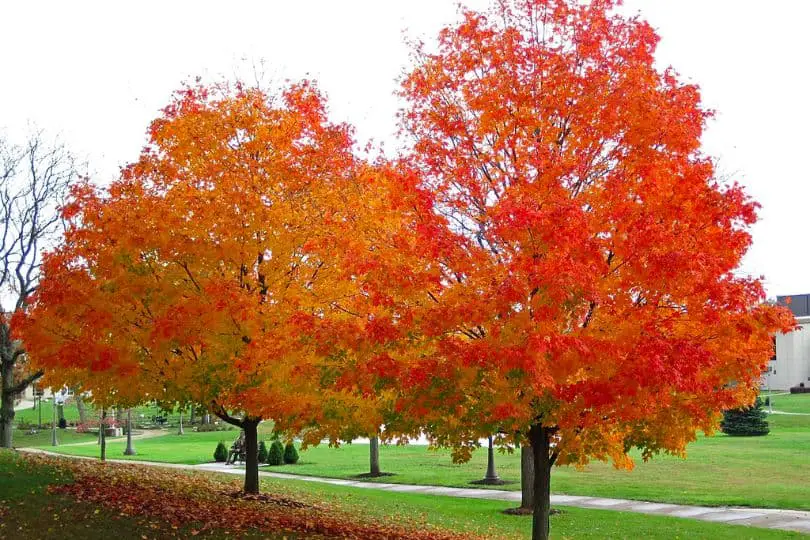
- Scientific Name: Acer saccharum Marshall
- Common Name(s): Sugar Maple, Rock Maple
- Mature Height: 90 feet (27 meters)
- Native Region: North America
- Flowers: No Flowers
- Fruits: Double samaras with wings varying from almost parallel to right-angled, maturing in autumn.
- Uses: Sugar maple wood is used for furniture, musical instruments, and flooring. The sap is tapped for maple syrup production.
The Sugar Maple, scientifically known as Acer saccharum Marshall, is a tall and stately tree found throughout Pennsylvania on damp wooded slopes. It grows to a mature height of around 90 feet (27 meters) and is also known as Rock Maple due to its strong wood.
Sugar Maple leaves are opposite, simple, and 5-lobed. They are brilliant green on top and pale green on the bottom, changing to vibrant colors of yellow, orange, or red in the fall. This tree has reddish-brown to orange-brown twigs and brown, sharp-pointed buds. Young trunks have smooth, gray-brown bark, whereas older trunks produce lengthy, uneven flakes through fissuring.
Sugar Maple wood, which is highly prized for its strength and durability, is one of its famous uses. It’s often used to make furniture, musical instruments, and flooring. Furthermore, the sap of the Sugar Maple is tapped in the spring for the production of maple syrup, making it an important commercial tree in Pennsylvania.
The Sugar Maple is a wonderful choice for broad open areas in landscaping. Its magnificent height and rich autumn foliage give beauty and visual appeal to any environment. Birds and rodents eat its seeds, while deer, squirrels, porcupines, and other creatures graze its twigs, buds, and bark.
When caring for a Sugar Maple in a Pennsylvania garden, it must be planted in a position with well-drained soil and partial shade. The tree tolerates a wide range of soil types but thrives in damp circumstances. Watering is required regularly, especially during dry spells. Pruning may be required to remove dead or diseased branches to maintain their health and attractiveness. To ensure correct care and maintenance of the Sugar Maple, it is suggested that you speak with a professional arborist.
6. Boxelder Maple
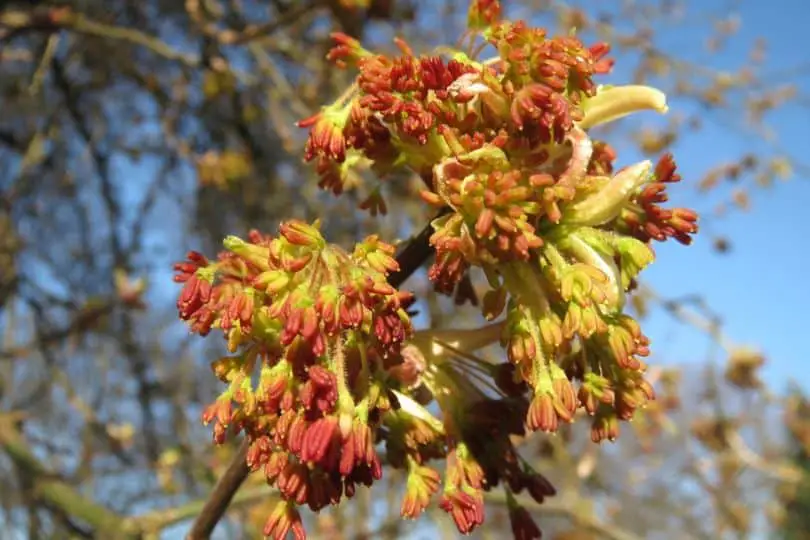
- Scientific Name: Acer negundo L.
- Common Name(s): Box Elder
- Mature Height: Up to 70 feet (21 meters)
- Native Region: Eastern and southern Pennsylvania, common along streams in the southwestern part, and scattered elsewhere in North America.
- Flowers: No flowers.
- Fruits: V-shaped wings about 1½”-2″ long, with narrow seeds, borne in drooping clusters. Fruits mature in September and remain far into winter.
- Uses: Used in ornamental plantings.
Box Elder, also known scientifically as Acer negundo, is a medium-sized tree that is popular in Pennsylvania gardens. It can reach a height of 70 feet and has a short trunk and robust branches that produce a deep, broad crown. The Box Elder’s leaves are opposite and complex, with 3-5 coarsely and irregularly toothed leaflets that are 2-4 inches long and 2-3 inches wide. The twigs are thick and purplish-green or green in color, with a whitish covering.
This tree is native to eastern and southern Pennsylvania, where it grows in low damp places, floodplains, and along stream banks. It can also be found in other areas of North America. Because of their gorgeous leaf and distinct form, Box Elders are frequently utilized in decorative landscapes.
Box Elder trees do not bloom, but they do have distinct fruits. The fruits are drooping clusters of V-shaped wings around 112-2 inches long with slender seeds. These fruits mature in September and remain on the tree throughout the winter, providing visual appeal to the tree.
Box Elders can grow in a variety of soil conditions, including moist or poorly drained soil, in Pennsylvania gardens. They prefer full sun or partial shade and are adaptable to urban settings. It is crucial to highlight that this tree has the potential to become invasive in some regions, therefore it is critical to monitor its growth and, if necessary, prevent its spread. Pruning regularly might help it keep its shape and promote healthy development.
7. Norway Maple
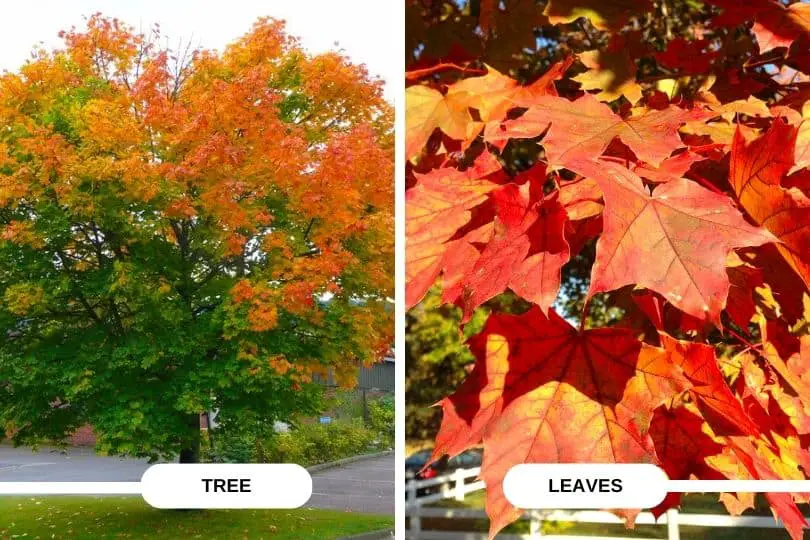
- Scientific Name: Acer platanoides L.
- Common Name(s): Norway Maple
- Mature Height: 50-60 feet (15-18 meters)
- Native Region: Northern Europe
- Flowers: No Flowers.
- Fruits: Wide spreading wings, maturing in autumn.
- Uses: Ornamental tree, shade tree, street tree.
The Norway Maple (Acer platanoides) is a deciduous tree that is widely seen in Pennsylvania gardens. It is native to Northern Europe, but it has been widely planted along city streets and in parks throughout the United States, including Pennsylvania.
The mature height of the Norway Maple is 50 to 60 feet (15 to 18 meters). Larger leaves, milky sap from the petiole, and fruit wings that spread outward are its distinguishing features.
The opposing, straightforward leaves of this tree, which are coarsely 5-lobed and range in width from 4 to 7 inches, stand out. When the leaf stalk is broken, it discharges a milky sap. Norway Maple twigs are thick and reddish-brown in hue. Bud scales contain keel-like ridges and are shiny crimson with green at the base.
The leaf scars on the twigs produce a sharp angle that encircles the twig. Young trees have smooth, light brown bark, whereas elder trees have dark, fissured bark that is not scaly.
The Norway Maple is typically found in disturbed woods and along roadsides. It frequently escapes cultivation and colonizes these places. It is known to be invasive in some areas as an introduced species because of its vigorous growth, which can outcompete native plants.
The Norway Maple is primarily employed as an ornamental and shade tree in Pennsylvania landscaping. Because of its ability to withstand urban environments, it is ideal for planting along city roadways. It provides enough shade as it gets tall and can serve as a focus point in gardens and parks. However, because of its invasive nature, caution should be exercised to prevent it from spreading to natural forest regions.
Regular trimming of the Norway Maple in Pennsylvania may be required to maintain its shape and prevent the emergence of weak branches. It prefers well-drained soil and may grow in various soil types, including sandy and clay soils. Adequate watering is required to sustain its health and vitality, especially during drought years.
Similar Articles
- Common Flowering Trees In Pennsylvania
- Common Pine Trees In Pennsylvania
- Common Cherry Trees In Pennsylvania
- Common Locust Trees In Pennsylvania
- Common Nut Trees In Pennsylvania
- Common Cedar Trees In Pennsylvania
- Common Palm Trees In Pennsylvania
- Common Birch Trees In Pennsylvania
- Common Aspen Trees In Pennsylvania
- Common Oak Trees In Pennsylvania
- Common Ash Trees In Pennsylvania
- Common Elm Trees In Pennsylvania
- Common Spruce Trees In Pennsylvania
- Pink Flowering Trees In Pennsylvania
- White Flowering Trees In Pennsylvania
- Purple Flowering Trees In Pennsylvania
Common Maple Trees In Pennsylvania – Sources
The Regional Gardening team makes sure that the information in our articles is accurate by only using sources that are known to be trustworthy. Some of these sources are peer-reviewed journals from government agencies, well-known universities, and scientific research organizations.
- Native Plant Resources, Pennsylvania Native Plant Society
- Trees & Shrubs Varieties, PennState Extension
- Landscaping With Natives, Pennsylvania Department Of Conservation, & Natural Resources
- Explore Pennsylvania Forests, Pennsylvania Department Of Conservation, & Natural Resources


